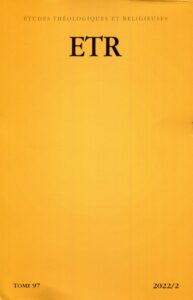Le récit du démoniaque de Gérasa, dans sa version marcienne (Mc 5,1-20), constitue le récit d’exorcisme le plus élaboré de tout le Nouveau Testament. La conjugaison de l’analyse synchronique (de type narratologique) avec une étude, pluridisciplinaire, des dimensions historiques, sociales et religieuses sous-jacentes au texte permet de mettre en valeur la force reconfiguratrice du récit. De manière plus ample, le micro-récit de l’exorcisme de Gérasa participe au projet mis en œuvre par l’auteur implicite à l’échelle du macro-récit que constitue l’Évangile de Marc. Dans cette perspective, il est possible d’apprécier la place et l’enjeu de Marc 5,1-20 dans la trame de l’Évangile de Marc, notamment en relation avec la figure du jeune homme qui s’enfuit nu (Mc 14,51-52) et avec la péricope qui met en scène le jeune homme au tombeau (Mc 16,1-8). Lire Marc 5,1-20 avec et après Marc 14,51-52 et 16,1-8 amène à une reconfiguration épistémique du lecteur relative aux thèmes de l’identité de Jésus, de la nature de la suivance et de la relation envisagée entre le disciple et son Maître absent.
Mots-clés : Évangile de Marc, Marc 5,1-20, démoniaque, Légion, analyse synchronique, analyse diachronique, macro-récit, micro-récit
Phrase : La thèse étudie le récit de la guérison du démoniaque en Marc 5,1-20 en perspective diachronique et synchronique.
The Gerasene and the young man (men): synchronic and diachronic perspectives of the story of the demoniac in Mark 5:1-20
The Gerasene demoniac in Mark (Mk 5:1-20) is the most developed story of exorcism in the whole New Testament. The conjuction of synchronic analysis (narrative type) with a pluridisciplinary study of the text’s historical, social and religious subjacent aspects reveals the reconfigurating force of the story. Even more, the micro-story of the Gerasene exorcism is typical for the author of the macro-story of Mark’s gospel. Thus the importance of Mark 5:1-20 in the whole of Mark’s gospel, particularly in relation to the young man who flees naked (Mk 14:51-52) and to the pericope of the young man at the tomb. Reading Mark 5:1-20 with and after Mark 14:51-52 and 16:1-8 leads the reader to an epistemic reconfiguration on the theme of the identity of Jesus, the nature of followship and the relationship foreseen between the disciple and his absent Master.
Keywords : Gospel of Mark, Mark 5:1-20, Demonic, Legion, synchronic analysis, diachronic analysis, macro-narrative, micro-narrative
p. 245-256
Auteur
MARULLI Luca
Luca MARULLI, docteur en théologie protestante, est Maître de conférences en Nouveau Testament à la faculté adventiste de théologie à Collonges-sous-Salève.
